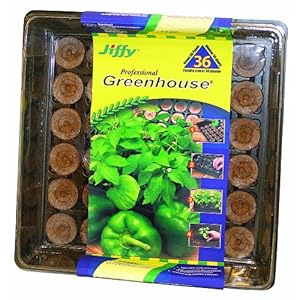Following on that though, the girls has another: Wouldn't it be awesome to sell tomatoes at the Farmer's Market? The kids and I spend a fair amount of time at the market over the summer and early fall, because I do free crafts and games for kids at the Blairstown market. To my girls, selling at the market is pretty much the apex of vegetable growing. It is somethign to aspire towards.
Obviously, I couldn't let that ideas get away. So, off we went for seeds and starter trays. The trays turned into quite the discussion at the store, because there are so many different types available now. It was a great opportunity to talk about "value added" items and how you can trade money to save time or make up for minimal expertise by selecting more expensive items. In the end, the girls selected a fairly inexpensive Jiffy seed starter greenhouse set.

We also spent time comparing the various tomato seeds and discussing why organic seeds are more expensive that conventional. This led to a talk about the practices used by different seed companies. And, of course, there was a discussion about the various varieties of cherry tomatoes available, planting times, days to maturity, etc. All of which led to a discussion about why it may be a better idea to research seed companies and use mail order catalogs next year, both for better price and better selection.
The next day we got to work planting the seeds. The girls wanted to know why you plant multiple seeds in each pot, then cut all but the strongest later. It was a great chance to review the fact that not every seed germinates and that you want to only keep the one strongest plant, rather than allow all the plants to compete for resources like water and sunlight, making them all weak. In total, we were hoping to have 36 cherry tomato plants!
By the way, I wanted to share a handy tip, for planting any smaller seed, passed down from my dad. We used toothpicks to make the tiny holes needed for the seeds. Then, touching the wet toothpick gently to the seed picks it up and makes it easy to transfer to the soil.
We also took to time to figure out a budget for how much their tomato business would cost to start and operate. We determined what the cost would be per pint of tomatoes we raise, and what we planned to charge for the produce. We factored in the cost of the initial seeds and pots, the soil, water and fertilizer over the season, pint containers to sell the tomatoes in, and even a fee to the market for selling our tomatoes. In the end we set a goal for how much we hope to make off of the project, after paying back expenses.
Before long, our plants germinated! Huzzah! Lots of leafy green. But the girls noticed that not every soil pellet had a plant. So I set Caitie to the task of counting those that had grown and we created a pie chart based on the data. We also talked about how we could calculate and express our germination rate. Now they're ready to go in the ground, and we'll be watching to see how they do from here.






No comments:
Post a Comment